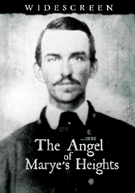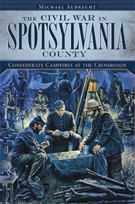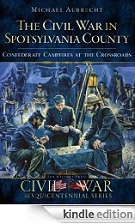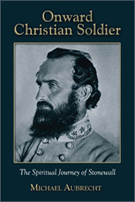BLOG, or DIE. Author Bio
Friday, 10 September 2010
Colonial Cribs
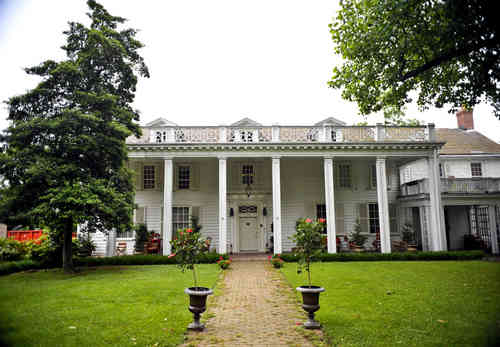
The Charles Dick House, Fredericksburg, VA (Photo by Rebecca Sell/The Free Lance-Star).
Earlier this week I noticed a ‘For Sale’ sign standing in the front yard of the Charles Dick House. Located at 1107 Princess Anne St, this gem is considered to be the oldest residence in Fredericksburg. Dating back to 1750, the master of this manor ran in circles that included George Washington who dined there in 1771. As a result, I thought I would share some related history on the neighborhood.
The original English settlement of Fredericksburg Virginia was chartered in 1728. Named for Frederick, Prince of Wales, the town’s footprint was clustered in a fifty-acre area along the west bank of the Rappahannock River. It was originally engineered in a grid-like pattern, with wide streets that were named after British royalty. The initial plot consisted of sixty-four equally sized lots with two extra spaces for a church and a market. As the population increased, Fredericksburg found it necessary to expand the municipal boundaries. By 1759, the city had tripled its physical size, opening the door to both new merchants and settlers alike.
Many significant names from both the Colonial and Revolutionary periods called Fredericksburg home to include George Washington, Fielding Lewis, Hugh Mercer, George Weedon, John Paul Jones and James Monroe. Thomas Jefferson, although not a resident, frequented the area on a number of occasions and penned the Virginia Statute for Religious Freedom there.
Although the tract on which Fredericksburg was founded had included a frontier fort that had been established in 1676, its firsthand witnessing of military action in the fight for independence was none. It was the other Fredericksburg, of New York, that witnessed one of the first armed incidents leading up to the American Revolution. In November of 1765, two regiments of British troops arrived from Poughkeepsie and merged with another 200 Redcoats from New York City who were deployed to stop the spread of British land encroachment by local Patriots.
Fredericksburg, Virginia that is, did make a significant contribution in the fight for liberty after Charles Dick teamed up with Fielding Lewis in 1775 to run the Fredericksburg gunnery. They would supply muskets for Colonial troops throughout the Revolution, while also repairing muskets captured from the British. The venture however, turned out to be far more patriotic than prosperous and is said to have taken its toll on their wealth and health. Lewis died in 1781, and Dick, who had been suffering from asthma since at least 1779, died in 1783 at the age of 68.
Unfortunately their spirit of enterprise did not survive either. By 1828, Fredericksburg residents realized that the development of their city was seriously lagging behind the nearby cities of Alexandria (to the north) and Richmond (to the south). As a result, they launched a thirty-year improvement plan that included a water navigation system and road improvements. Fredericksburg also wanted to compete with the nearby town of Falmouth, which had established a stable economy based on the industrial processing of flour. By 1830, both towns collectively boasted a flour-inspection rate of 125,000 barrels a year. However, output dropped dramatically to under 60,000 barrels annually in 1847. This decline hurt the local economy and did nothing to help cover the costs of the city’s fledging revitalization plans.
Many of Fredericksburg’s long-term projects proved to be poorly planned or executed. By 1858, most had fallen into bankruptcy after uncoordinated and intermittent attempts to complete them were unsuccessful. The news editors of the Semi-Weekly News, Christian Banner and Weekly Advertiser spared no words when they wrote pieces taking the citizens to task for their “lack of energy and enterprise,” as well as their penchant for mediocrity. Clearly the town’s officials did not anticipate the requirements of their plans, nor did they prepare any contingencies in the event of failures.
Regardless of these difficulties, Fredericksburg righted itself economically and was able to continue on the path of progress by adding shipping to their resume by means of river and railroad. This expansion however would come to a screeching halt as the War Between the States would literally roll over the town like no other in the region. Reconstruction would take decades.
The town, which had been officially incorporated in 1781, finally received its charter as an independent city in 1879. Although it is primarily remembered today for hosting four major battles in the Civil War, Fredericksburg did play a big part in the settlement of the Old Dominion, a small part in it’s fight for independence, and is home to such historic sites as Ferry Farm, Kenmore Plantation, Chatham, Mary Ball Washington’s House, the Rising Sun Tavern, Hugh Mercer’s apothecary shop, James Monroe’s Law Office and of course, Charles Dick’s house, which you can own for a cool $1.28 million.

Thursday, 9 September 2010
A quick update...
...as I am busy preparing for screenings at Liberty University and the University of Mary Washington. I have not gone totally Hollywood and will be contributing a cover story for the Jan/Feb issue of Patriots of the American Revolution on the “Black Loyalists of New Brunswick,” reviewing 2 new titles by Thomas Lowry for The Free Lance-Star, releasing the copy for Mort Kunstler’s next masterpiece “Unconquered Spirit,” and sharing a special post on Colonial Fredericksburg. I will also post pics and videos from the road here and on The Angel of Marye’s Heights blog. Stay tuned. I thank you for your continued patience and support.
If you want to keep up with my schedule and possibly attend an upcoming event, I would love to meet you in person. Here is what’s currently booked for the remainder of the year: September 18: Film Screening, Lynchburg, VA (Liberty University) - September 25: Film Screening, Fredericksburg, VA (University of Mary Washington) - October 9: Book Signing, Germanna Community College (Locust Grove) - October 21: Presentation, Stafford VA (County Courthouse Administration Center) - November 13: Book Signing and Vignette, (Gray Ghost Vineyards and Winery) - November 20 & 21: Film Screening, Spotsylvania, VA (Spotsylvania Presbyterian Church) - November 27: Film Screening, Pittsburgh, PA (Carnegie Library Music Hall).
Posted by ny5/pinstripepress
at 10:14 AM EDT
Updated: Thursday, 9 September 2010 2:54 PM EDT
Permalink |
Share This Post

Friday, 3 September 2010
See the film and meet us!
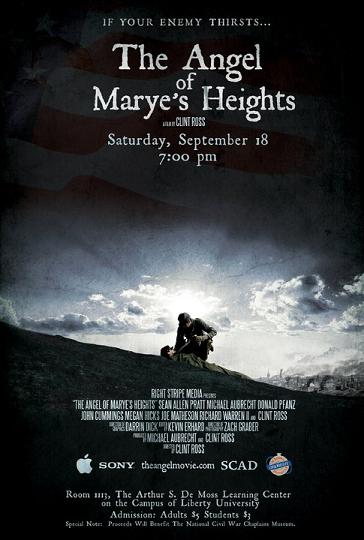
UPDATE: Look for an upcoming interview with us in the Liberty Champion newspaper and listen on Sept. 18, for our live interview on Victory FM WRVL (Find a station)
SEPT. 18 (Open to public): The Angel of Marye’s Heights will be showing at Liberty University on Saturday, September 18, 7:00-9:00 PM (DeMoss Learning Center, Room 1113) ADMISSION: Adults $5, Students $3. ALL ticket proceeds benefit the National Civil War Chaplains Museum. In addition to the 30-minute film, producers and attending cast will provide brief comments. For more info contact Kenny Rowlette at 434-582-2087. (Meet Michael Aubrecht, Clint Ross, Richard Warren II and Darrin Dick)
SEPT. 25 (Open to MWU Family Weekend attendees only): The Angel of Marye’s Heights will be showing at Mary Washington University’s Family Weekend on Saturday, September 25, 3:00-4:00 PM (Lee Hall 411) WEEKEND ADMISSION: Family $15. In addition to the 30-minute film, producers and attending cast will provide brief comments. A separate tour of the Brompton mansion atop Marye’s Heights will follow. For more info on this event and/or for directions and parking information visit MWU’s Family Weekend site. (Meet Michael Aubrecht and John Cummings)

Thursday, 2 September 2010
Circle of Life
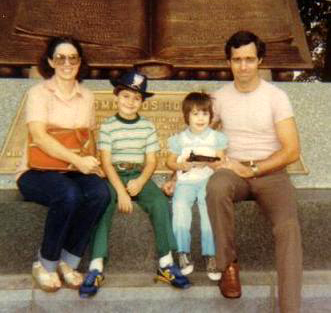
High Water Mark in Gettysburg, 1978 (Tom Aubrecht)
Today’s post is a little different from the usual faire here at Blog or Die. It’s not about the American Revolution or the Civil War. It’s not about the Founding Fathers, or a movie, or book project. It’s simply about me.
This past weekend I had the pleasure of taking my mother and father out for a private tour. This was the first time that I’ve done something like this and I can definitely say that it was surreal (in a good way). It also had a lasting impact on me and prompted this post that I’d like to share today.
Taking advantage of napping grandchildren, my parents and I visited the Fredericksburg Battlefield, a site they had taken me to as a child. After walking the Sunken Road, scaling Marye’s Heights and strolling through the National Cemetery, we concluded our jaunt with a brief visit to the Eastern National bookstore where they saw two of my titles (Houses of the Holy and Campfires at the Crossroads) sitting on the shelf in the ‘Local Interest’ section.
It was then that I realized my life had come full circle. I’m a couple years away from the big 4-0 and I can easily say that thirty-something years before, we were probably in the same place - doing the same thing. It was a proud moment for me for sure.
This is not the first time I’ve felt nostalgic. Years ago I penned a short, sappy piece titled Birth of a Buff (READ HERE) that recalled my first trip to Gettysburg. In retrospect, that weekend turned out to be a life-changing experience that I treasure to this day.
For those of you who came to appreciate Civil War history in your adulthood, I’m one of those ‘LIFERS’…a geek that’s been obsessed since I was 7 years old. My parents took me to a plethora of sites in my youth including Gettysburg, Fredericksburg, New Market, Monticello, Fort Ligonier and Williamsburg. I can remember every single one of them as if it was yesterday.
As an adult, my father and I have traveled to Gettysburg, Antietam, Manassas, Winchester and Kernstown. As a Spotsylvania resident, I live in the vicinity of Fredericksburg, Chancellorsville, Spotsylvania and The Wilderness. Yep, feel free to hate me. I am unabashedly spoiled in access to hallowed grounds.
This tour was a little different as it ended in an NPS bookstore, with books on a shelf, penned by me, that would not have been possible if not for the very same trips that I had taken, to the very same locations in my youth. It was like playing “six-degrees of me.”
I don’t say that to sound prideful (OK maybe a little), but I’m trying to illustrate how there is a clear path that can be traced in my life between then and now. If my parents had never taken me on these trips, and then put up with the general weirdness that comes when you want to dress up like a re-enactor before you’re old enough to know what they are, who knows what and where I would be.
Would I still be writing books and producing films? Would I even live in Fredericksburg? Probably not.
Simply put, THIS is what made me who I am today and I’m grateful for it. At the same time I'm also a little sad that my four kids have ZERO interest in traipsing around battlefields. (That is until they come out with something for the Wii.)
As a parent, I pray that they will have lives that are complete and fulfilling, even if they will never know the joy that I experienced, at the ages of 7 and now at 38, with my parents, on a battlefield, in a bookstore.
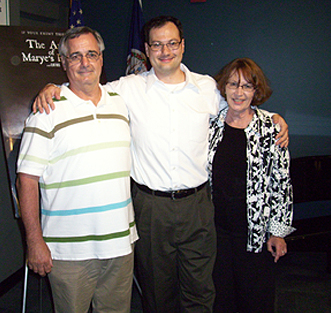
Angel of Marye's Heights premiere in Fredericksburg, 2010 (Tracy Aubrecht)
Posted by ny5/pinstripepress
at 12:24 PM EDT
Updated: Thursday, 2 September 2010 10:26 PM EDT
Permalink |
Share This Post

Monday, 30 August 2010
My Mistake
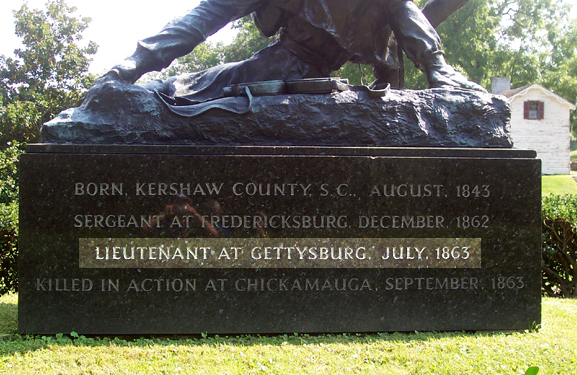
ABOVE: The back face of the Richard Kirkland Monument at the Fredericksburg Battlefield (M. Aubrecht)
Following the release of our documentary Clint and I arranged for several members of the local National Park Service to attend a private screening online. None of these gentlemen were directly involved with the project and we were very anxious to get their unbiased critiques. All of them obliged us and we are very grateful for their compliments and validation. Several of these historians are high-ranking authorities and their positive reviews left us with a tremendous sense of satisfaction (and relief).
In addition to their praise, they also offered up some constructive criticisms. One recurring issue that we were kindly, but consistently pinged on was the closing statement that Richard Kirkland had perished in combat as a lieutenant. This is wrong. As an ongoing debate over the validity of the story of "The Angel of Marye's Heights" is a hot-button topic (see Mysteries & Conundrums 3-part series), I thought that I would comment on this particular error.
Richard Kirkland was NOT a lieutenant - and Yes - I am the one who said so on camera. I believe my line goes something like: "Kirkland, who was a lieutenant at the time, was leading a group of men forward in battle when he accidentally advanced further ahead than his lines, putting himself in imminent danger." I said this when describing Kirkland's untimely demise at the Battle of Chickamauga. I've been saying it for years in both my presentations and tours.
Most of our critics agreed that this common mistake has been repeated for well over a century and that it was understandable that I would cite the fact in my own writings and commentary. This error was first stated in the 1880 Kershaw interview and it is also engraved on the back of the Kirkland Monument on the Fredericksburg Battlefield.
That said, I was still wrong and immediately wondered how such an apparent error could be so widespread and propagated for 130 years. I did a little research on the subject and have identified the following sources (including those penned by my own hand) to share. I do this not to defer or excuse my own error, but to illustrate how history must constantly be re-evaluated for accuracy and that none of us are perfect.
EXHIBIT 1: is taken directly from the Gen. J.B. Kershaw interview that was printed on page 1 of The News and Courier, Camden, S.C., January 2, 1880. In it Kershaw states that: "Little remains to be told. Sergt. Kirkland distinguished himself in battle at Gettysburg and was promoted to lieutenant. At Chickamauga he fell on the field of battle, in the hour of victory. He was but a youth when called away, and had never formed those ties from which might have resulted a posterity to enjoy his fame and bless his country; but he has bequeathed to the American youth, yea to the world, an example which dignifies our common humanity." (Note: The Southern Historical Society Papers, Vol. VIII. Richmond, Virginia, No. 4 reprinted the article in April of that year.)
EXHIBIT 2: Mrs. Harold Hough, a historian for the John D. Kennedy Chapter of the UDC, Camden, SC, Kershaw County Historical Society cited Kirkland as a lieutenant in the opening line of her study entitled "A Rebel Against Injustice Richard Kirkland, Young Humanitarian of Kershaw County, South Carolina." She stated: "On September 20, 1863, Lieutenant Richard Kirkland, died in an unsuccessful spearhead attack before victory at Chickamauga. His last words, ‘Save yourselves, men and tell Pa I died right,' exhibited the same pattern of unselfishness he had shown less than a year before at Fredericksburg when he became known as the ‘Angel of Marye's Heights.'"
EXHIBIT 3: Cut to years later...my own take on the matter quoted from the lecture "Great Lives That Touched Fredericksburg During the Civil War: The Angel of Marye's Heights" which was delivered to the FCWRT at Mary Washington University. In the section titled "Gettysburg" I state, "By the time of the Battle of Gettysburg, Kershaw had been promoted to a brigadier general in McLaw's Division of Longstreet's Corps. His regiments (including Kirkland's 2nd) fought in the woods and fields of the George Rose farm as well as the infamous Wheatfield. It is said that Kirkland performed with great courage and distinguished himself in battle. He was enthusiastically promoted to the rank of Lieutenant."
EXHIBIT 4: Perhaps the most telling of all when examining how inaccurate history can be forever preserved and propagated is the rear inscription on the actual Richard Kirkland Monument which stands as perhaps the most recognized and significant statuary on the entire Fredericksburg Battlefield. In a summary of Kirkland's life it states: "Born Kershaw County, S.C., August, 1843 • Sergeant at Fredericksburg, December 1962 • Lieutenant at Gettysburg, July, 1863 • Killed in action at Chickamauga, September 1863."
Mac Wyckoff, a retired NPS historian and the leading authority on Richard Kirkland and the 2nd South Carolina recently penned a piece as part of an upcoming book that offers an explanation of how and why this happened.
In "Appendix B: THE ANGEL OF MARYE'S HEIGHTS CONTROVERSY" Mac states that: "The last controversy concerning Kirkland is his rank at the time of his death. As noted above, Kershaw stated that Kirkland was promoted from sergeant to lieutenant for gallantry at Gettysburg. There is no evidence to support this statement. At Gettysburg the captain of the Kirkland's company was killed and two lieutenants wounded, one seriously. It is therefore logical that as 1st sergeant, Kirkland became acting lieutenant and if he had lived longer would have been promoted. But the wheels of bureaucracy move slowly often taking many months before promotions became official. Kirkland's Compiled Service record at the National Archives clearly shows 1st sergeant as his rank when killed at Chickamauga. An article in the Camden newspaper listing the local soldiers killed at Chickamauga shows Kirkland's rank as sergeant."
Kirkland's obituary, printed on October 16, 1863 also correctly stated that he: "Fell, in the battle of Chickamauga, Sergeant R. R. Kirkland, in the 23d year of his age," and the Camden Volunteers post-war roster lists Kirkland as, "Sergeants: Richard Rowland Kirkland - Angel of Mercy promoted in the summer of 1862 - died at Chickamauga."
So Kershaw, Hough, DeWeldon and I all contributed in our own way to the propagation of this error by keeping it alive through our own works. A number of recent Civil War books have also quoted Kirkland at a higher rank and we all likely used the same sources in our research. Although I feel somewhat vindicated to be in such good company, I've said in the past that poor research leads to poor history and that our writings will be someone else's sources.
This is a perfect example of what happens when we assume things to be completely factual, simply because those who came before us did. Now as the producers of a documentary on Richard Kirkland, we can acknowledge his true rank when we have the opportunity and educate our audience beyond the film.

Newer | Latest | Older

